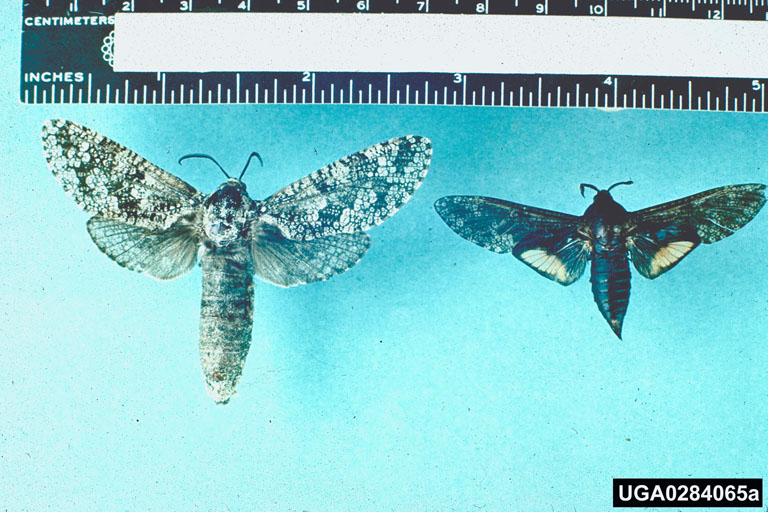|
Cossidae Genera
The Cossidae, the cossid millers or carpenter millers, make up a family of mostly large miller moths. This family contains over 110 genera with almost 700 known species, and many more species await description. Carpenter millers are nocturnal Lepidoptera found worldwide, except the Southeast Asian subfamily Ratardinae, which is mostly active during the day. This family includes many species with large caterpillars and moths with a wingspan from . These moths are mostly grey; some have long, narrow wings and resemble hawkmoths (Sphingidae) which are more advanced macrolepidoptera, however. Many are twig, bark, or leaf mimics, and Cossidae often have some sort of large marking at the tip of the forewing uppersides, conspicuous in flight, but resembling a broken-off twig when the animals are resting. Caterpillars are smooth with a few hairs. Most cossid caterpillars are tree borers, in some species taking up to three years to mature. The caterpillars pupate within their tunnels ... [...More Info...] [...Related Items...] OR: [Wikipedia] [Google] [Baidu] |
Cossula Magnifica
''Cossula magnifica'', the pecan carpenterworm moth, is a moth of the family Cossidae found in the southeastern parts of United States, from North Carolina south to Florida, and west to Mississippi and Texas. The wingspan is 32–45 mm. Adults are on wing from March to June depending on the location. The larvae feed on ''Carya'' species, including ''Carya illinoinensis'', but also on ''Diospyros'' and ''Quercus An oak is a tree or shrub in the genus ''Quercus'' (; Latin "oak tree") of the beech family, Fagaceae. There are approximately 500 extant species of oaks. The common name "oak" also appears in the names of species in related genera, notably ...'' species. External linksBug Guide Cossulinae Taxa named by Herman Strecker Moths described in 1876 {{Cossoidea-stub ... [...More Info...] [...Related Items...] OR: [Wikipedia] [Google] [Baidu] |
Prionoxystus Robiniae
''Prionoxystus robiniae'', the carpenterworm moth or locust borer, is a moth of the family Cossidae. It was first described by Peck in 1818 and it is found in southern Canada and most of the United States. The wingspan is 43–85 mm. Adults are on wing from May to July depending on the location. The larvae feed on locust, oak, chestnut, poplar, willow, maple and ash Ash or ashes are the solid remnants of fires. Specifically, ''ash'' refers to all non-aqueous, non- gaseous residues that remain after something burns. In analytical chemistry, to analyse the mineral and metal content of chemical samples, ash .... The species is considered a pest, because the tunnels the larvae create decrease the value of hardwood lumber. References External links * Cossinae {{Cossinae-stub ... [...More Info...] [...Related Items...] OR: [Wikipedia] [Google] [Baidu] |
Metarbelidae
The Metarbelidae are a family of the Cossoidea also called the carpenter or goat moths, and is sometimes treated as a subfamily, Metarbelinae of the Cossidae. No synapomorphies are shared with the Cossidae based on adult morphology. The family Metarbelidae was first described by Embrik Strand in 1909. Distribution The family Metarbelidae is most diverse on the African mainland (occurs only south of the Sahara). The family is absent in the New World, Europe, northern Asia, Australia and have a very scattered occurrence on Madagascar and in the Oriental Region through the southwestern and southern Arabian Peninsula., 2009: Six New Species of Metarbelidae (Lepidoptera: Cossoidea) from the Eastern Arc Mountains of Tanzania, Including One New Species from Marenji Forest in Southeast Coastal Kenya. ''Journal of East African Natural History'' 97 (2): 187-206. DOI: 10.2982/0012-8317-97.2.187. Abstract Genera * '' Aethiopina'' Gaede, 1929 * ''Arbelodes'' Karsch, 1896 * '' Bjoernstadia'' L ... [...More Info...] [...Related Items...] OR: [Wikipedia] [Google] [Baidu] |
Fishing Bait
Fishing bait is any substance used to attract and catch fish, e.g. on a fishing hook. Bait items are both selected from and placed within the environment to achieve enhanced prey capture success. Traditionally, fishing baits are natural fish food such as night-crawlers, insects, worms, and smaller bait fish that have been used for catching fish. Fishermen have also begun using processed food, plastic baits and more recently, bionic lures to attract fish. Despite the importance of fish's attraction to bait, the way fish react to different baits is quite poorly understood. The various techniques and bait that a fisher may choose is dictated mainly by the target species and by its habitat. Bait can be separated into two main categories: artificial baits and natural baits. The alternative of artificial and live baits frequently demonstrate similar efficiency. The overall bait type and size will affect the efficiency and results of catches when fishing. With these two common w ... [...More Info...] [...Related Items...] OR: [Wikipedia] [Google] [Baidu] |
Pet Food
Pet food is animal feed intended for consumption by pets. Typically sold in pet stores and supermarkets, it is usually specific to the type of animal, such as dog food or cat food. Most meat used for animals is a byproduct of the human food industry, and is not regarded as "human grade".Hickman, LeoBritain's problem with pets ''The Guardian'', November 13, 2009. In 2019, the world pet food market was valued at US$87.08 billion and is projected to grow to US$113.2 billion by the year 2024. The pet food market is dominated by five major companies, as of 2020: Mars, Inc., Nestle Purina Petcare, J. M. Smucker, Hill's Pet Nutrition, Inc. (owned by Colgate-Palmolive), and Blue Buffalo Co. Ltd (owned by General Mills). Industry In the United States, pet-food sales in 2016 reached an all-time high of $28.23 billion. Mars is the leading company in the pet food industry, making about $17 billion annually in pet-care products. Online sales of pet food are increasing and contributing to ... [...More Info...] [...Related Items...] OR: [Wikipedia] [Google] [Baidu] |
Chilecomadia Moorei
The Chilean moth (''Chilecomadia moorei'') is a moth of the family Cossidae. The butterworm is the larval form and is commonly used as fishing bait in South America."The Incredible Edible Worm", by Audrey Pavia, ''Reptiles Magazine'', July, 2007 Butterworms, like mealworms, are used as food for insectivore pets, such as geckos and other reptiles, as their scent and bright color help attract the more stubborn eaters. They are also called tebo worms or trevo worms, and are high in fat and calcium. They are difficult to breed in captivity, and most are imported directly from Chile. They are usually irradiated Irradiation is the process by which an object is exposed to radiation. The exposure can originate from various sources, including natural sources. Most frequently the term refers to ionizing radiation, and to a level of radiation that will serve ... to kill bacteria and prevent pupation as the moth is an invasive species. References Pet foods Chilecomadiinae Fish ... [...More Info...] [...Related Items...] OR: [Wikipedia] [Google] [Baidu] |
Chile
Chile, officially the Republic of Chile, is a country in the western part of South America. It is the southernmost country in the world, and the closest to Antarctica, occupying a long and narrow strip of land between the Andes to the east and the Pacific Ocean to the west. Chile covers an area of , with a population of 17.5 million as of 2017. It shares land borders with Peru to the north, Bolivia to the north-east, Argentina to the east, and the Drake Passage in the far south. Chile also controls the Pacific islands of Juan Fernández, Isla Salas y Gómez, Desventuradas, and Easter Island in Oceania. It also claims about of Antarctica under the Chilean Antarctic Territory. The country's capital and largest city is Santiago, and its national language is Spanish. Spain conquered and colonized the region in the mid-16th century, replacing Inca rule, but failing to conquer the independent Mapuche who inhabited what is now south-central Chile. In 1818, after declaring in ... [...More Info...] [...Related Items...] OR: [Wikipedia] [Google] [Baidu] |
Australia
Australia, officially the Commonwealth of Australia, is a Sovereign state, sovereign country comprising the mainland of the Australia (continent), Australian continent, the island of Tasmania, and numerous List of islands of Australia, smaller islands. With an area of , Australia is the largest country by area in Oceania and the world's List of countries and dependencies by area, sixth-largest country. Australia is the oldest, flattest, and driest inhabited continent, with the least fertile soils. It is a Megadiverse countries, megadiverse country, and its size gives it a wide variety of landscapes and climates, with Deserts of Australia, deserts in the centre, tropical Forests of Australia, rainforests in the north-east, and List of mountains in Australia, mountain ranges in the south-east. The ancestors of Aboriginal Australians began arriving from south east Asia approximately Early human migrations#Nearby Oceania, 65,000 years ago, during the Last Glacial Period, last i ... [...More Info...] [...Related Items...] OR: [Wikipedia] [Google] [Baidu] |
Endoxyla Leucomochla
''Endoxyla leucomochla'' is a species of cossid moth endemic to Australia. The larva of the moth is commonly known as the "witchetty grub", and is widely used as bush tucker by Indigenous Australians. CSIRO. The caterpillars of the species live in tunnels where they feed on the sap from the roots of the witchetty bush ('''') and the small cooba (''''). The caterpillar grows to a length of about 7 cm, and |
Bush Tucker
Bush tucker, also called bush food, is any food native to Australia and used as sustenance by Indigenous Australians, the Aboriginal and Torres Strait Islander peoples, but it can also describe any native flora or fauna used for culinary or medicinal purposes, regardless of the continent or culture. Animal native foods include kangaroo, emu, witchetty grubs and crocodile, and plant foods include fruits such as quandong, kutjera, spices such as lemon myrtle and vegetables such as warrigal greens and various native yams. Traditional Indigenous Australians' use of bushfoods has been severely affected by the settlement of Australia in 1788 and subsequent settlement by non-Indigenous peoples. The introduction of non-native foods, together with the loss of traditional lands, resulting in reduced access to native foods by Aboriginal people, and destruction of native habitat for agriculture, has accentuated the reduction in use. Since the 1970s, there has been recognition of the n ... [...More Info...] [...Related Items...] OR: [Wikipedia] [Google] [Baidu] |
Outback
The Outback is a remote, vast, sparsely populated area of Australia. The Outback is more remote than the bush. While often envisaged as being arid, the Outback regions extend from the northern to southern Australian coastlines and encompass a number of climatic zones, including tropical and monsoonal climates in northern areas, arid areas in the "red centre" and semi-arid and temperate climates in southerly regions. Geographically, the Outback is unified by a combination of factors, most notably a low human population density, a largely intact natural environment and, in many places, low-intensity land uses, such as pastoralism (livestock grazing) in which production is reliant on the natural environment. The Outback is deeply ingrained in Australian heritage, history and folklore. In Australian art the subject of the Outback has been vogue, particularly in the 1940s. In 2009, as part of the Q150 celebrations, the Queensland Outback was announced as one of the Q150 Icons of Q ... [...More Info...] [...Related Items...] OR: [Wikipedia] [Google] [Baidu] |





